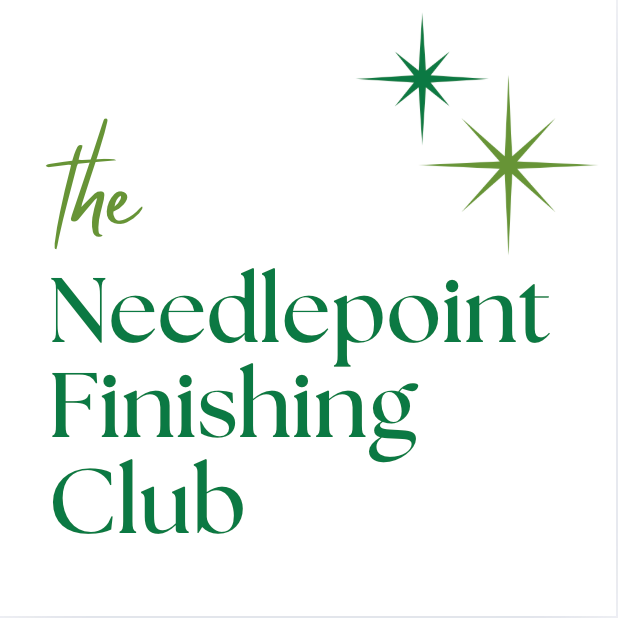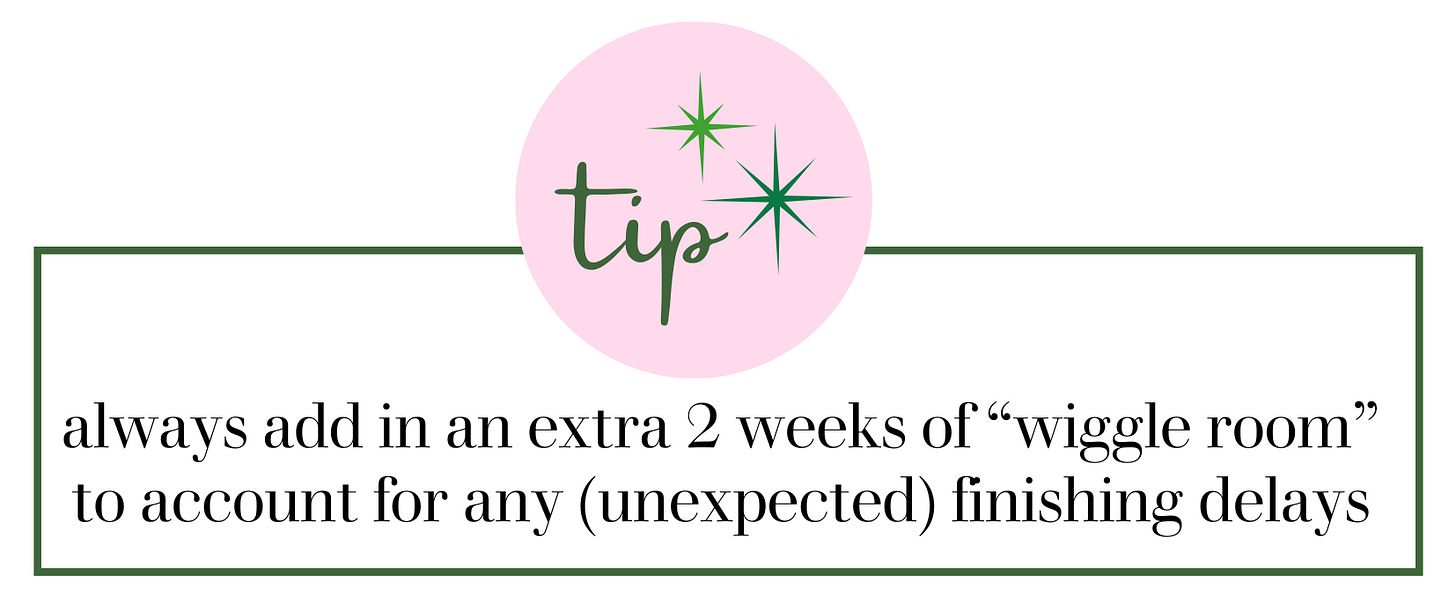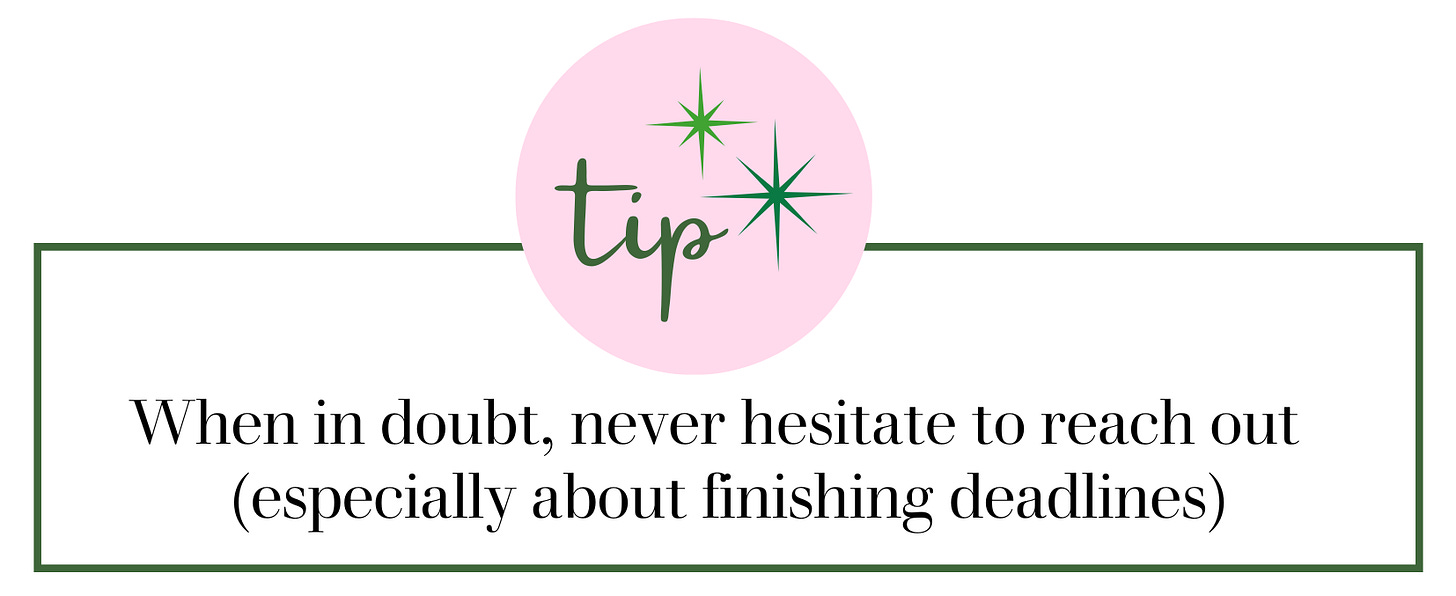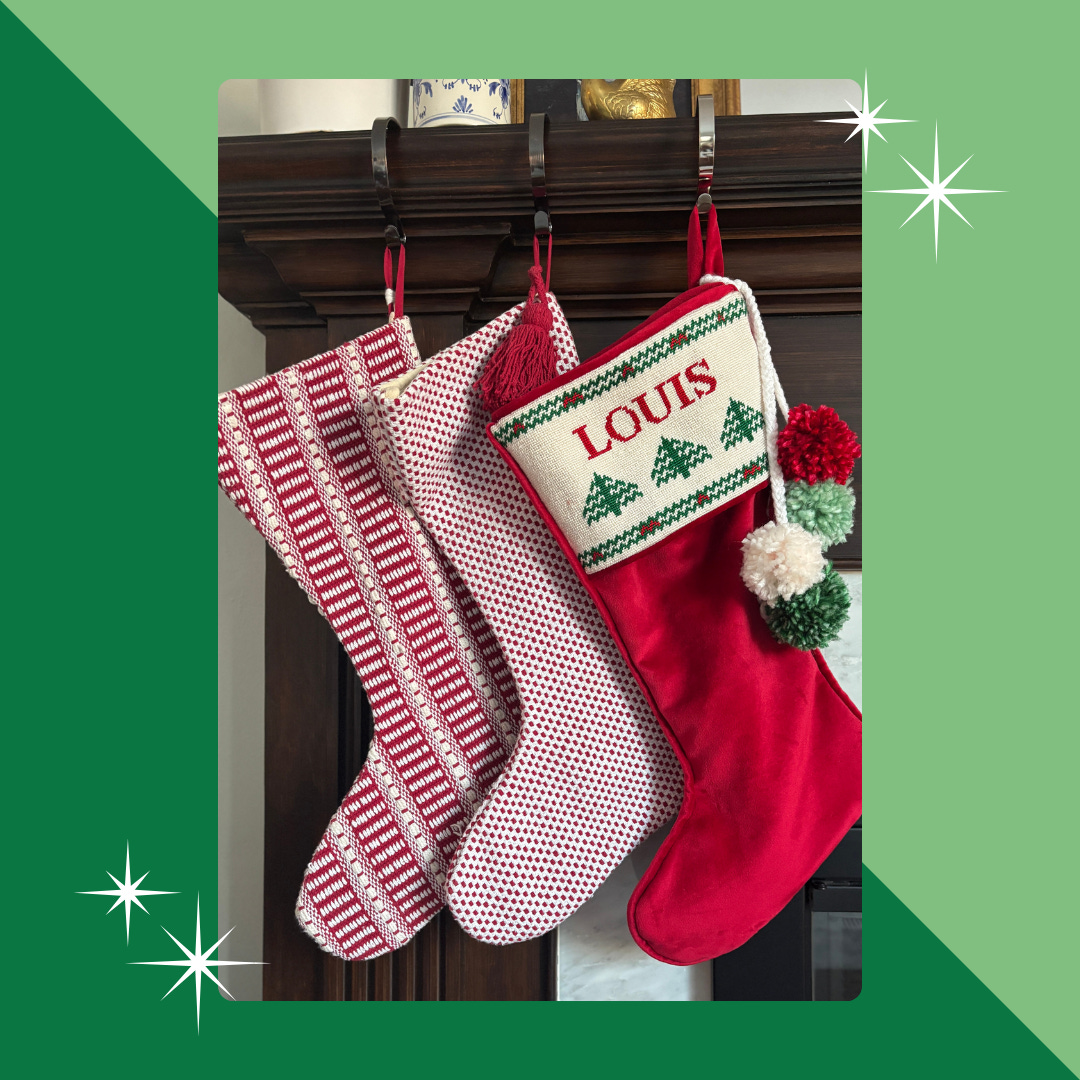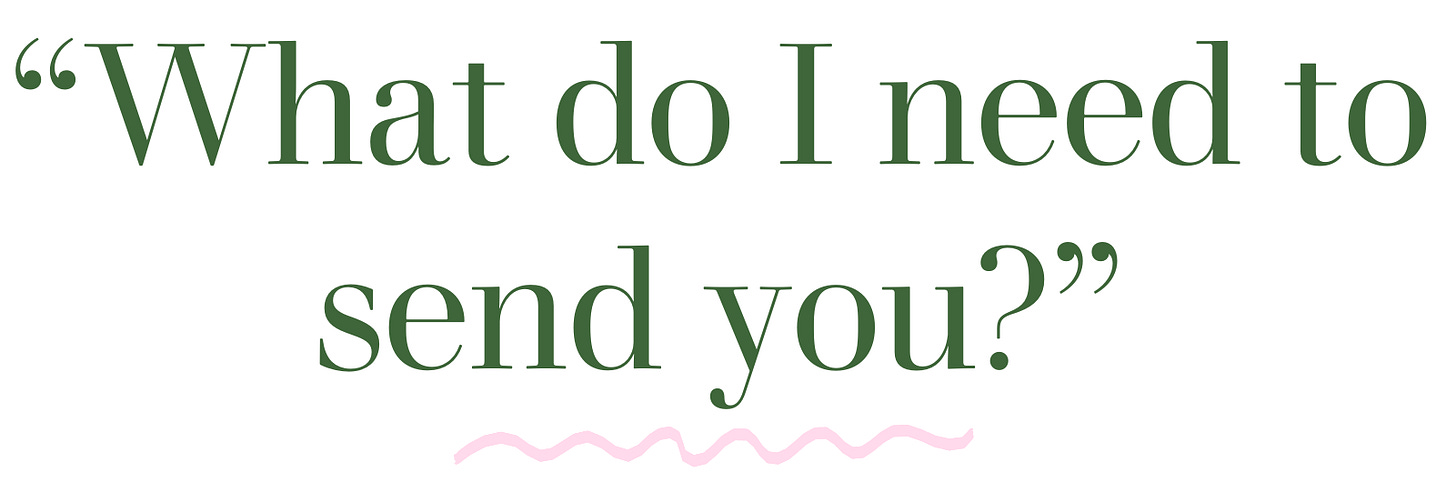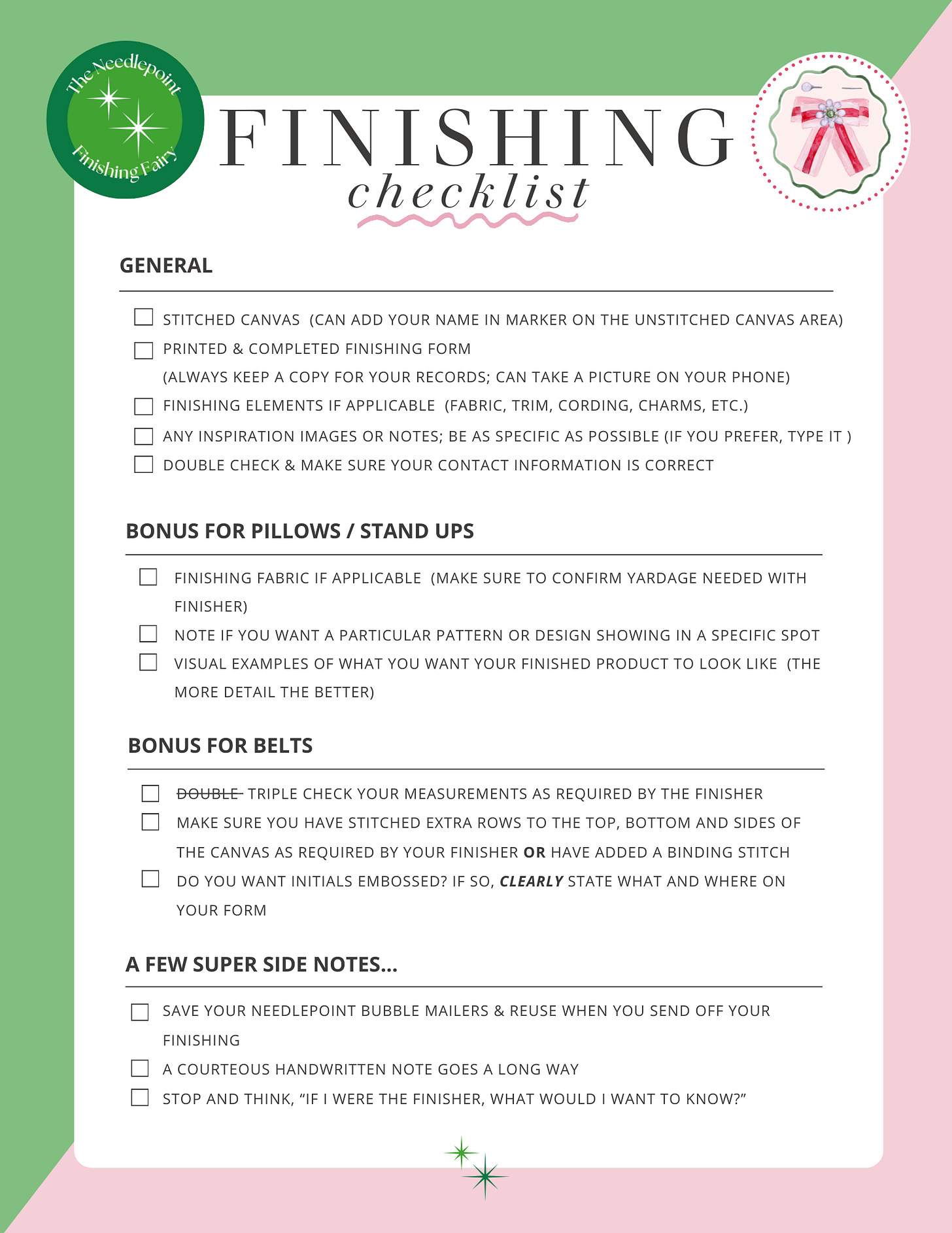Stop, Collaborate and Listen
Needlepoint Relationship Advice for Stitchers & Finishers feat. The Finishing Fairy
How stitchers & finishers can avoid missteps and get exactly what they want, together.
In my *very humble* opinion there are two distinct and defining moments in a needlepointer’s stitching “journey” that we all experience:
1.) the “last stitch” feeling - when you thread in the last stitch of a project and voila! your masterpiece is completely stitched
and
2.) the big reveal - when the needlepoint finishing is complete (by yourself or someone else) and your canvas has been transformed into something much more….an heirloom. A stitched piece of your unique creativity that is undeniably you.
But what happens when either one of these instances don’t leave you feeling elated and excited?
Well, if this occurs during the last stitch of a canvas, you can always (begrudgingly) remove and re-stitch any areas you do not care for - as painful as that may be.
BUT
What happens when you are not happy with the finished result? Cue the frustration, devastation (in the least dramatic way possible, of course) and tears. This feeling is in a league of its own.
And here’s the thing, we’ve all been there—you pour your heart (and let’s be honest, a small fortune) into a needlepoint project, only to end up with a finished piece that’s…well….not quite what you envisioned. Le sigh.
(Unboxing a belt I stitched for my brother as a Christmas gift- which I received back with the wrong belt buckle. The LNS was so helpful in working with me to get the right buckle on ASAP)
But here’s the good news: instances like these are a chance to learn and grow (something we can never do enough of)—for both stitchers and finishers. That’s why my dear friend, Amanda (aka “the Finishing Fairy”) and I have teamed up to bring you this post: packed with practical advice, honest insights, and perspectives from both sides of the fence to help you:
Trust the process (and yourself)
communicate your vision clearly and
create something fabulous together.
Think of this as a heart-to-heart with two friends who have “been there” and who are here to make sure you never second guess your finishing choices again.
P.S. If you are reading this and are curious to learn more about the process of finishing, and perhaps even finish on your own, I highly recommend checking out Amanda’s Substack.
Plan Early, Avoid Stress
In a world where our scrolling thumbs race quicker than our minds, it is imperative to take the time to stop, think and thoughtfully plan out “must complete” project(s) for the year. Part of an ornament exchange? When is the submission deadline? Want to gift an ornament for an engaged couple? When’s the big day? You get the gist. This will help identify the projects you absolutely need and want to complete and will help you to allocate your time and resources accordingly.
Stitcher’s Perspective (Emily):
Every January, I start stitching a surprise birthday belt for my husband for his birthday the following year. His birthday is in January, so to have the finished belt in hand by the preceding December, it needs to be in the finisher’s hands at the end of June. Thinking ahead like this alleviates stress and helps me budget my time and attention to ensure the perfect (on-time) gift.
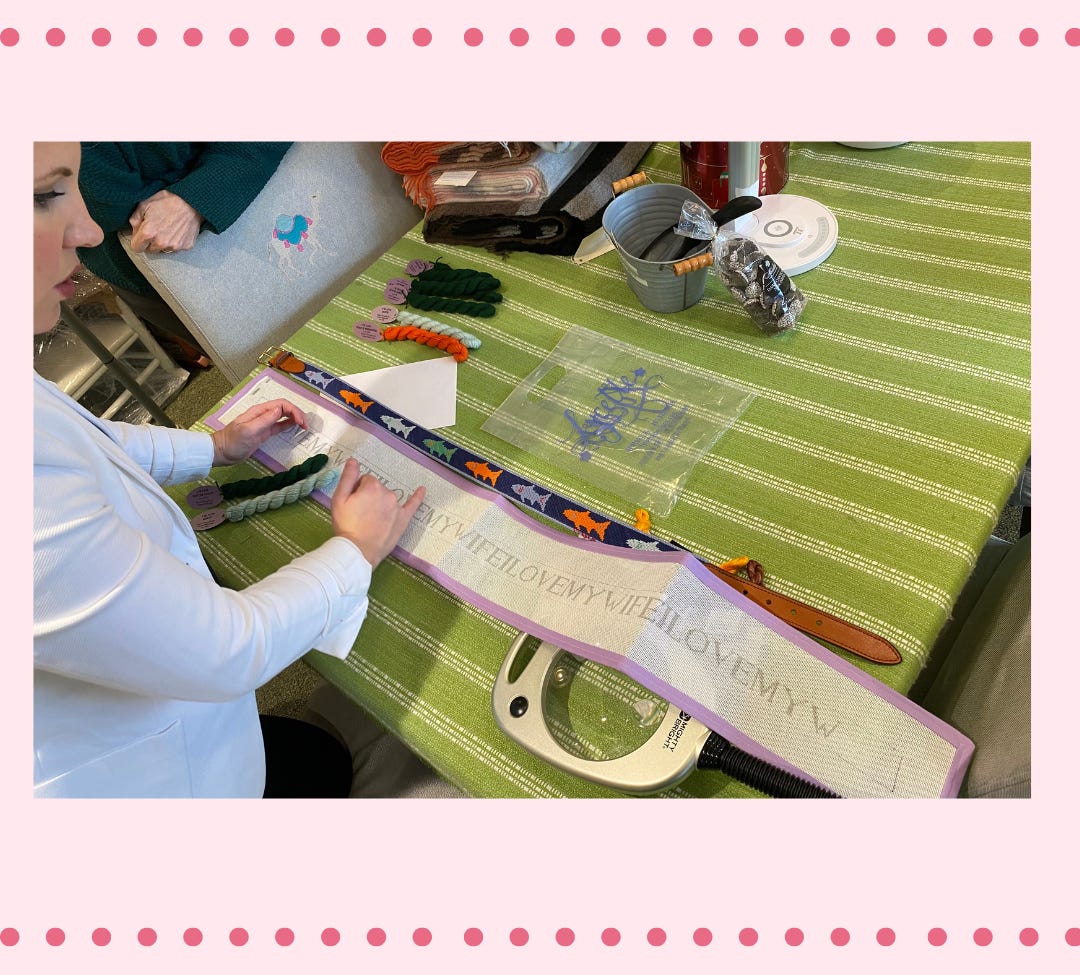
Finisher’s Perspective (Amanda):
As a finisher, I can’t stress enough the importance of planning ahead for both parties. With the boom in stitching the last few years, there are simply not enough finishers to meet demand. Getting your canvas to me (or any finisher) early ensures your project is given the time it deserves to come to life as you have envisioned.
Having trouble organizing your thoughts and what projects to focus on? Check out Amanda’s free organizing and planning tools featured in this post.
Remember, the earlier you plan, the better your chances are of meeting your deadline!
Do not be afraid to reach out to a finisher and ask about current finishing timelines. Often this information will be on their online finishing form or website too. Regardless if they are finishing your items or not, this is helpful insight for other projects you may want to partner on in the future and is precisely how relationships are cultivated.
Find a Finisher
This is very much “which came first: the chicken or the egg?” It may seem backwards to find your finisher second, but it is so helpful to first be crystal clear with yourself on timing and expectations for your projects. Understanding your timetable will narrow down the options of finishers who can accommodate and from there you can move forward. You owe it to yourself (and your project) to find a finisher you trust will bring your vision to life (which may even be you)!
Stitcher’s Perspective (Emily):
The best place to start is always with someone you trust. There is a reason “Phone a Friend” was coined as a lifeline on “Who Wants To Be A Millionaire”. Ask close stitching friends, DM the person on Instagram whose finished items you saved, or work directly with a LNS who has a trusted reputation in finishing. Any one of these will help point you in the right direction if it is something they cannot accommodate.
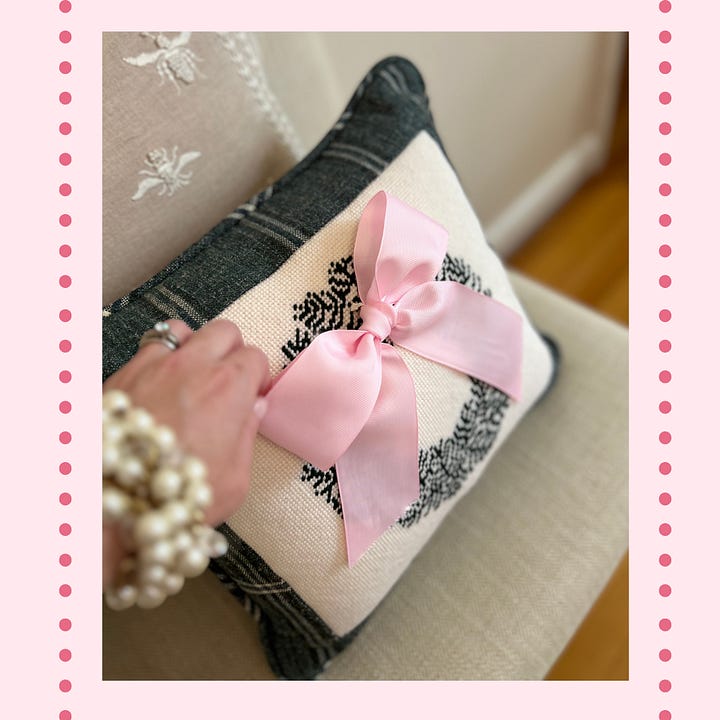
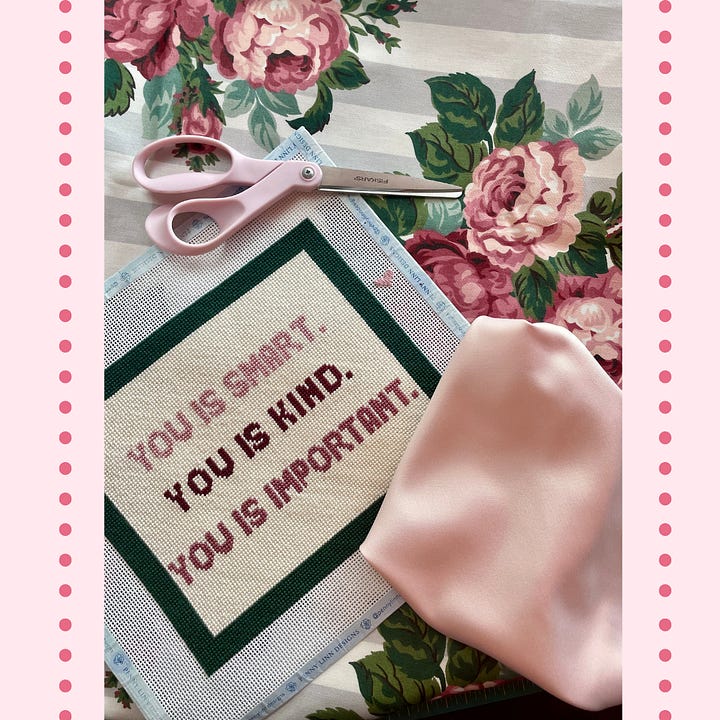
Finisher’s Perspective (Amanda):
Echoing what Emily said above, trusted stitcher recommendations are like gold. I can confidently say that 99% of independent finishers are extremely reputable, professional businesswomen and men who excel at their craft and have been in business for years. Below is some more detail behind types of finishers to explore - with more and more finishing services launching monthly as the needlepoint community continues to grow.
Shop-Supported Finishing: Many shops partner with vetted independent finishers, offering trusted quality control and sometimes the materials required (e.g. finishing fabric options). This is a huge value your shop is bringing but it may add time (and sometimes cost) to your finishing process.
Direct-to-Consumer Finishers: Some finishers are direct-to-consumer and work directly with clients. Most times, these individuals specialize in a variety of projects but many also specialize in a specific type of project (e.g. belt finishing or pillow finishing) and some even bring decades of experience.
Holiday or part time: During the holidays, self-finishers often take on simpler projects like ornaments for friends or clients via social media to help stitchers meet their gifting deadlines. As with anything, vet the work carefully, ask for referrals, don’t pay in advance, and use payment methods that offer protection (e.g. using the “goods and services” payment option on Venmo).
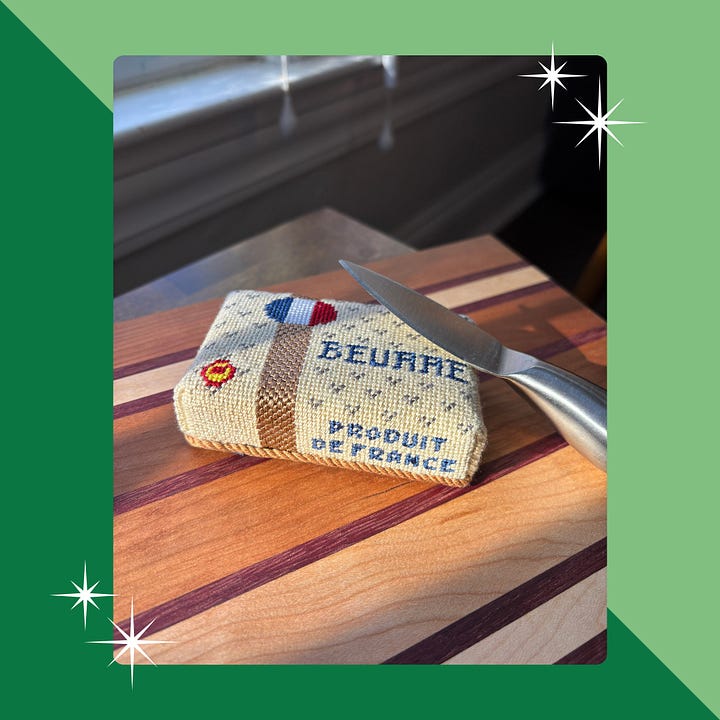
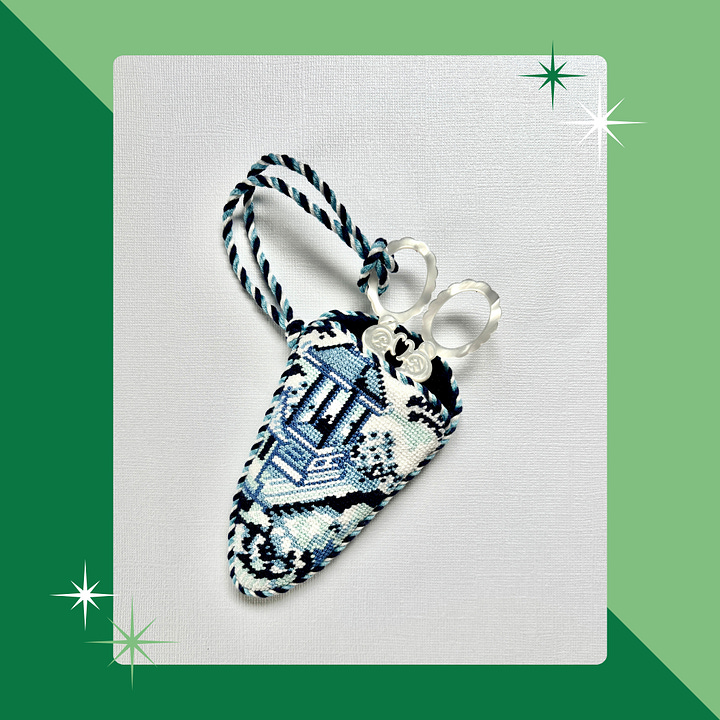
Articulate Your Vision
This very well may be the most trying part of the entire finishing process. When a stitcher has a project ready for finishing, it usually falls into one of three categories:
Crystal Clear Vision: The stitcher has mapped out (and may have even provided) all the details for the project such as fabric, trim, etc. They simply need a finisher to assemble and bring everything to life.
Work In Progress: The stitcher has an idea of what they want the canvas finished into but need a finisher’s touch to fill in the gaps and bring it all together.
Finisher’s Choice: The stitcher gives the finisher full liberty to finish the project as they choose.
Regardless of which category you find yourself in, this is the most crucial stage as it can make or break your project. This is where it is imperative to be totally honest with yourself and to listen.
Listen to what your instinct is telling you (do you really like that fabric?)
Listen to the advice of others (specifically your finisher), if you solicit it.
Even if you do not heed their advice, really listen to what your finisher is saying and vice versa for finishers listening to their clients. A finisher can offer objective insight as well as tactical advice from their finishing practices and experience . Most importantly, for both stitchers and finishers, do not settle. If something doesn’t feel or look right, it probably isn’t. (Kindly) speak up. This will only foster a stronger confidence in your next steps together.
When you take the time to stop, drown out the “noise” and listen, it will make articulating your vision much easier.
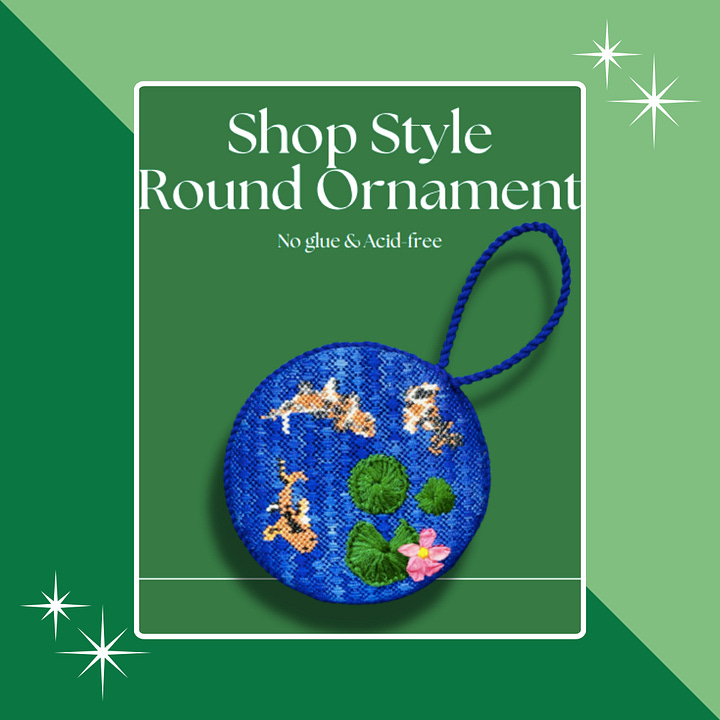
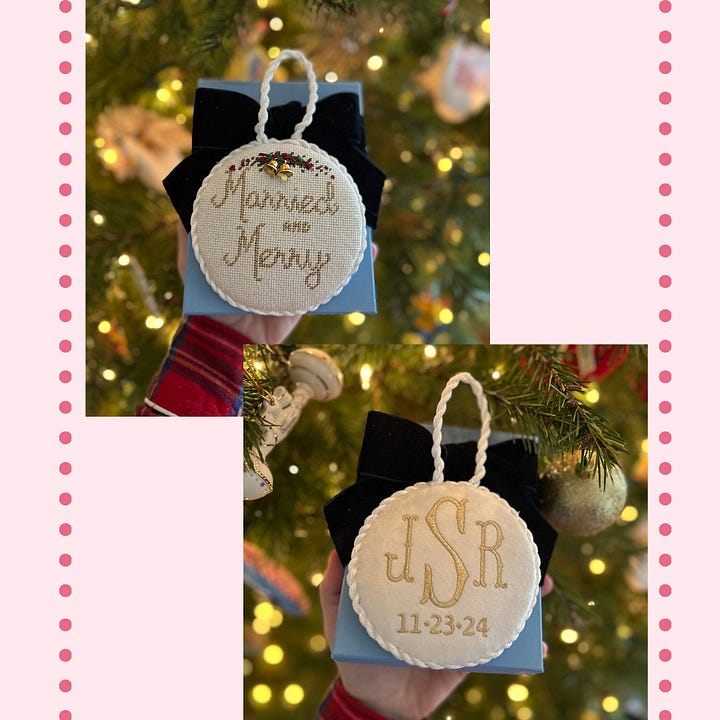
And Most Importantly….
Another burning, million dollar question. It is important to note that many finishers have different preferences and ways of collecting your information when it comes to finishing. However, there are some consistencies I (Emily) have noticed across finishers, as well as some very painful lessons learned.
When I (Emily) send out my projects to be finished, here is what I present my finisher with:
Finishing form (always make a copy of the completed form to keep for yourself)
Fabric for finishing (already monogrammed by my monogrammer) with notes on where I want the monogram showing
If finishing a pillow, is there a particular part of the pattern I want showing and where? I note this in an enclosed note.
Cording or miscellaneous textiles (e.g. charms)
A clear, printed image of what I want the finished item to look like (e.g. ornament shape, puffy or not puffy; if so, how “puffy”)
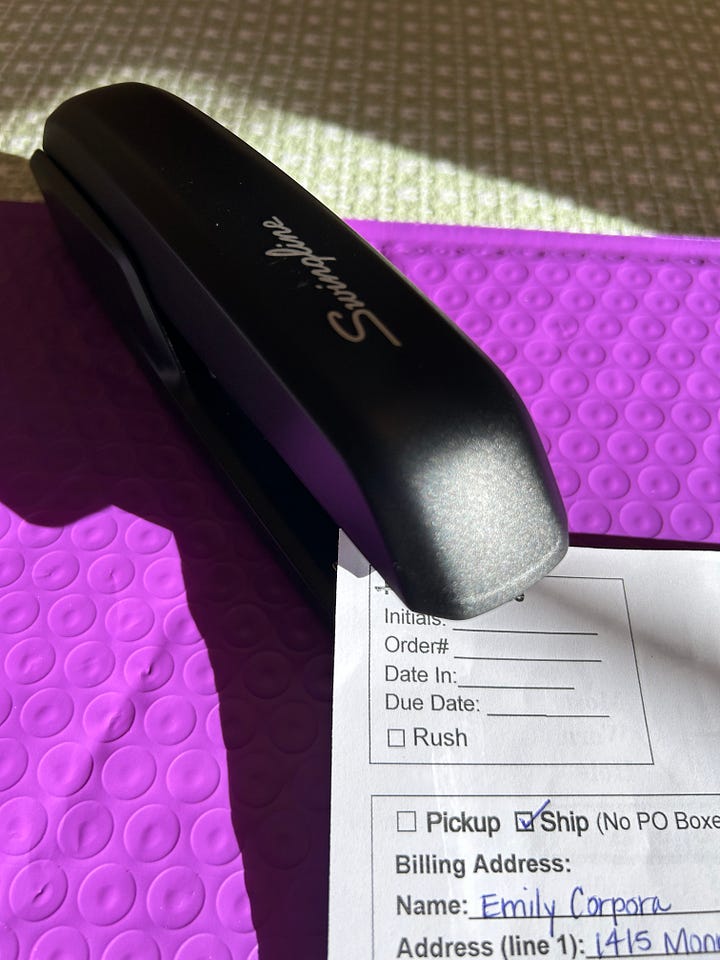
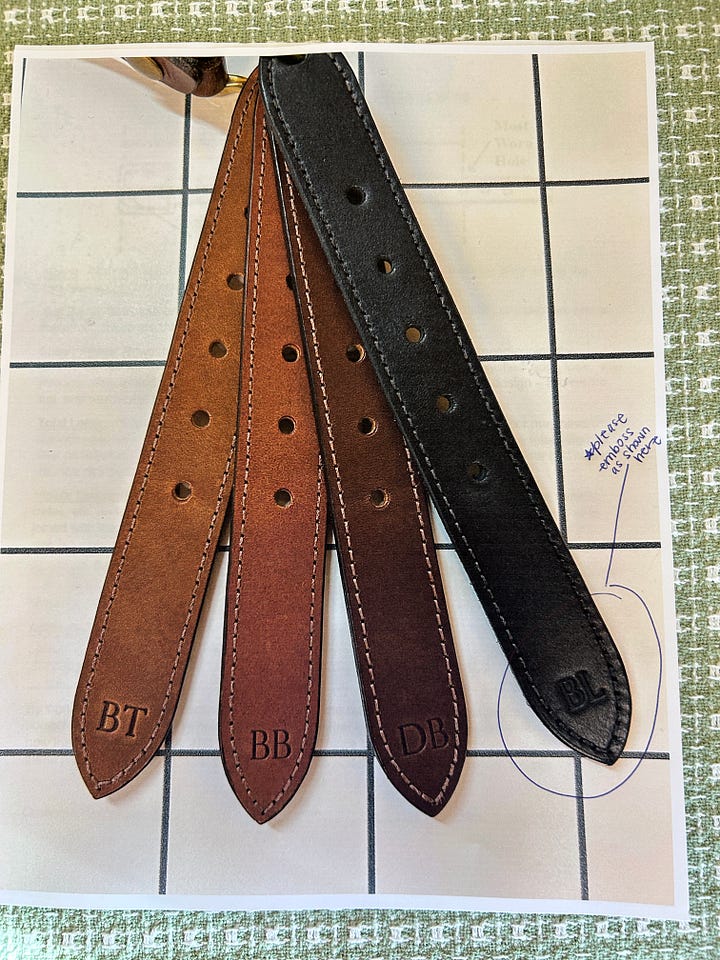
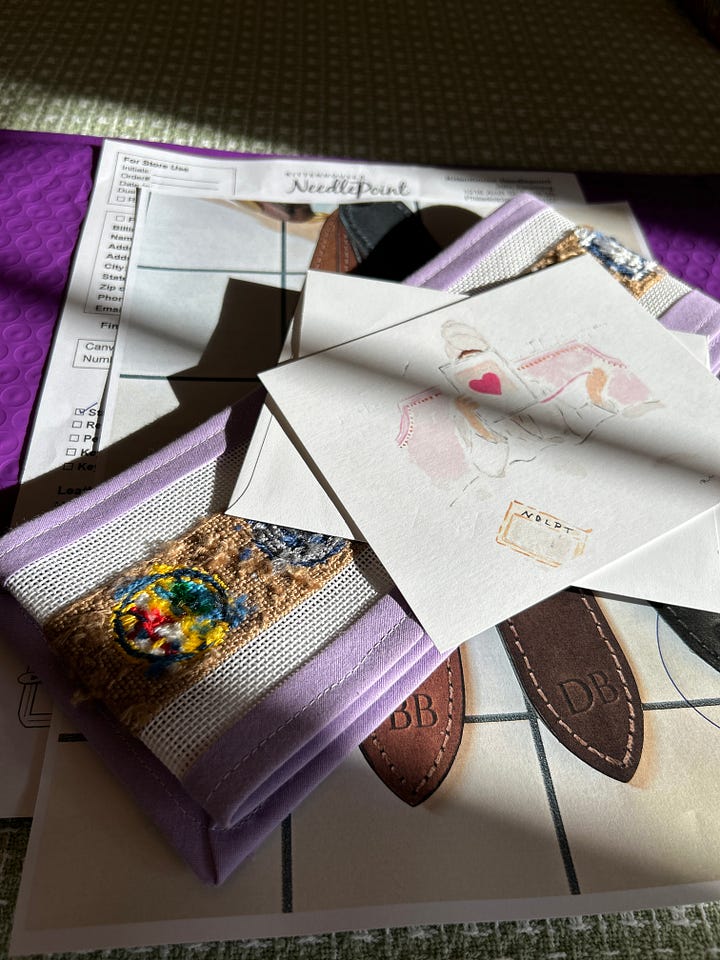
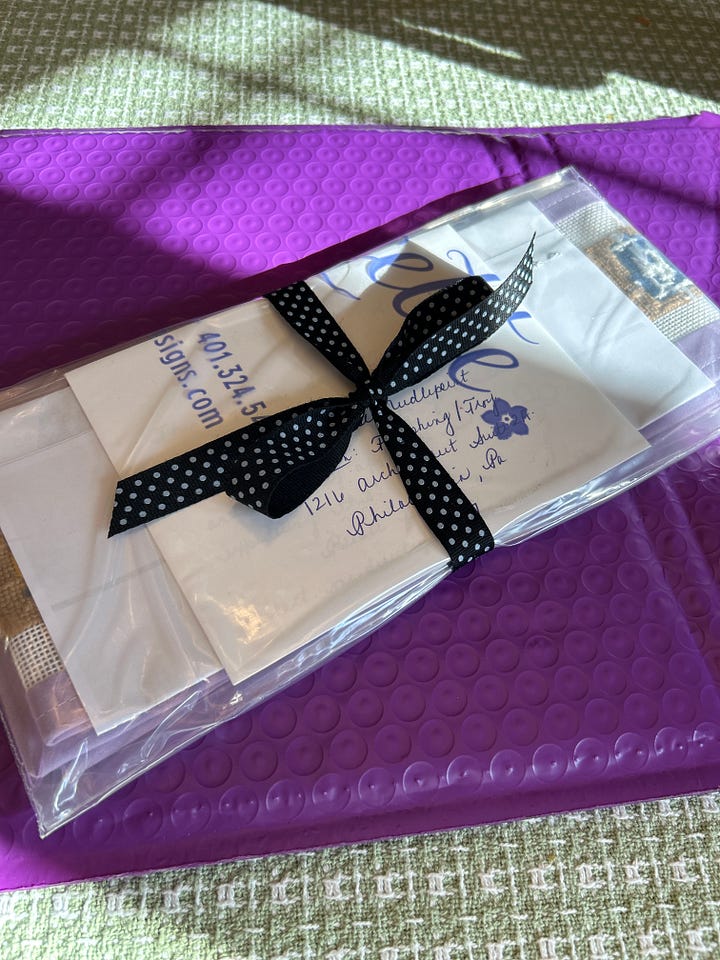
Finisher’s Perspective (Amanda):
Even if you don’t have all these details that Emily outlined, providing ideas or inspiration is most appreciated, especially for items outside of the normal finishing style for that finisher. A simple example is a self-welt on a standup. It’s not something I have done commercially, but because I do it on flats often, I can definitely add it to a standup. Sometimes if it is a new format or new style, we can reverse engineer it together.
If you are not sure if your finisher can do something in particular just ask! The worst they can say is "no" and even if they do, I can almost guarantee they will have a strong recommendation for you as to who can bring your vision to life.
The relationship between stitcher and finisher really is the most important one in needlepoint. At its heart, needlepoint is a labor of love—a beautiful blend of a stitcher’s creativity and the finisher’s expertise…sometimes those two are one in the same (cc: all the self finishers out there). By planning thoughtfully, communicating openly, and trusting the process, you can transform your stitches into something truly extraordinary. Mistakes might happen, but they’re part of the journey, and every experience makes you a stronger stitcher (and collaborator).
So, take a moment, trust in the power of collaboration and remember, your stitches tell a story—and your finishing does too.
What finishing questions or “lessons learned” do you have? We would love to know (and help if we can) - drop them in the comments section below this post.
xoxo,
Emily & Amanda
Listen to our conversation here (click on the image below):
Screenshot, download or save this to your phone for the next time you send something off for finishing!
Please note, this checklist was compiled based on our shared experiences. When in doubt about something, always ask your finisher.









